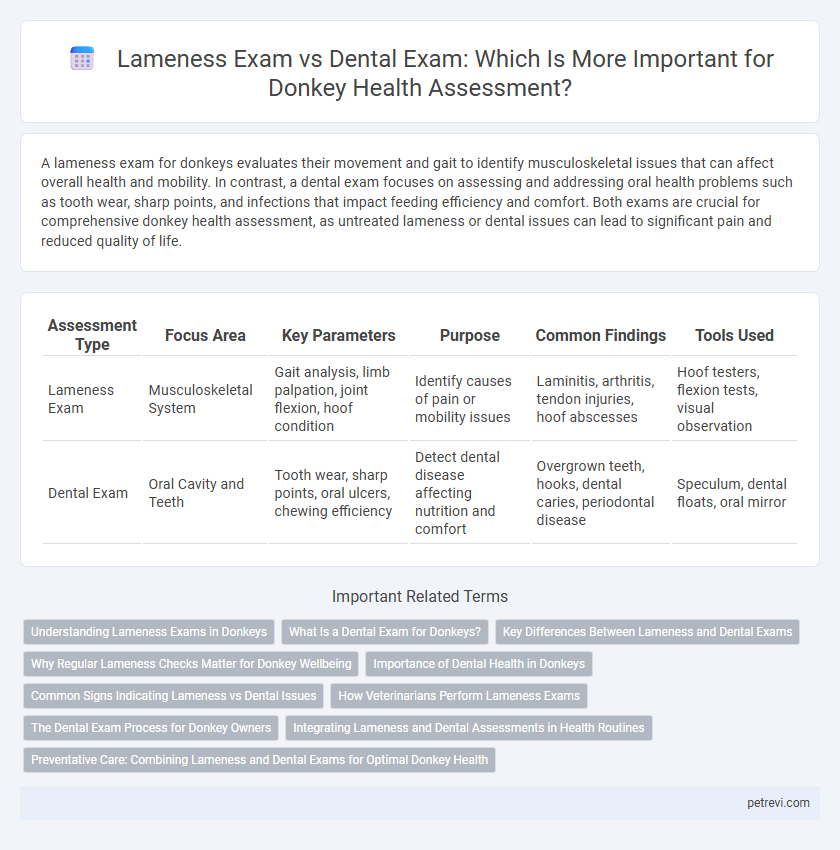A lameness exam for donkeys evaluates their movement and gait to identify musculoskeletal issues that can affect overall health and mobility. In contrast, a dental exam focuses on assessing and addressing oral health problems such as tooth wear, sharp points, and infections that impact feeding efficiency and comfort. Both exams are crucial for comprehensive donkey health assessment, as untreated lameness or dental issues can lead to significant pain and reduced quality of life.
Table of Comparison
| Assessment Type | Focus Area | Key Parameters | Purpose | Common Findings | Tools Used |
|---|---|---|---|---|---|
| Lameness Exam | Musculoskeletal System | Gait analysis, limb palpation, joint flexion, hoof condition | Identify causes of pain or mobility issues | Laminitis, arthritis, tendon injuries, hoof abscesses | Hoof testers, flexion tests, visual observation |
| Dental Exam | Oral Cavity and Teeth | Tooth wear, sharp points, oral ulcers, chewing efficiency | Detect dental disease affecting nutrition and comfort | Overgrown teeth, hooks, dental caries, periodontal disease | Speculum, dental floats, oral mirror |
Understanding Lameness Exams in Donkeys
Lameness exams in donkeys focus on identifying gait abnormalities, pain, or swelling that indicate musculoskeletal issues, using palpation, flexion tests, and observation of movement. These exams help detect conditions like hoof abscesses, joint inflammation, or tendon injuries that directly impact mobility and overall well-being. Unlike dental exams, which assess oral health and nutrition, lameness exams target locomotor system integrity essential for donkey performance and quality of life.
What Is a Dental Exam for Donkeys?
A dental exam for donkeys involves a thorough inspection of the teeth, gums, and oral cavity to identify issues such as sharp enamel points, tooth decay, or malocclusion that can affect feeding and overall health. This examination typically includes visual assessment and may use specialized tools like a speculum and dental floats to check for uneven wear or damaged teeth. Regular dental exams are essential for preventing pain, weight loss, and secondary health problems in donkeys by ensuring proper oral function and comfort.
Key Differences Between Lameness and Dental Exams
Lameness exams for donkeys focus on assessing gait abnormalities, joint flexibility, and hoof condition to identify musculoskeletal issues, while dental exams evaluate tooth wear, alignment, and oral health to prevent feeding problems. Lameness assessments often include palpation, flexion tests, and locomotion analysis, contrasting with dental exams that involve visual inspection, flotation, and detection of sharp enamel points or dental deformities. Understanding these key differences is crucial for targeted donkey health management and improving overall welfare.
Why Regular Lameness Checks Matter for Donkey Wellbeing
Regular lameness exams are vital for detecting early signs of pain or injury in donkeys, which can significantly impact their mobility and overall quality of life. Unlike dental exams that focus on oral health, lameness assessments evaluate the musculoskeletal system, identifying issues such as hoof problems, joint inflammation, or tendon injuries. Consistent lameness monitoring helps prevent chronic conditions, supports timely treatment, and enhances the long-term wellbeing of donkeys.
Importance of Dental Health in Donkeys
Dental exams are crucial for donkeys as they directly impact feeding efficiency and overall health, with issues like sharp enamel points or tooth decay leading to weight loss and discomfort. While lameness exams assess mobility and musculoskeletal health, neglecting dental health can cause chronic pain and secondary lameness due to uneven weight distribution. Regular dental check-ups help detect and prevent conditions such as periodontal disease and malocclusion, ensuring optimal donkey well-being and performance.
Common Signs Indicating Lameness vs Dental Issues
Common signs indicating lameness in donkeys include uneven gait, reluctance to bear weight on a limb, and noticeable swelling or heat in the affected leg. In contrast, dental issues often manifest as difficulty chewing, excessive salivation, weight loss, and foul-smelling breath. Regular lameness exams focus on mobility and limb condition, while dental exams assess oral health, teeth alignment, and signs of infection or decay.
How Veterinarians Perform Lameness Exams
Veterinarians perform lameness exams on donkeys by observing their gait at various paces and assessing weight-bearing on each limb to detect abnormalities. They palpate limbs and joints, evaluate hoof balance, and may implement flexion tests to pinpoint discomfort or mobility issues. Diagnostic tools such as nerve blocks, radiographs, and digital imaging are often employed to confirm the source of lameness for precise treatment.
The Dental Exam Process for Donkey Owners
The dental exam process for donkey owners involves a thorough inspection of the donkey's mouth to identify sharp enamel points, uneven wear, or dental infections that can impair feeding and overall health. Regular dental assessments typically include floating the teeth, removing any overgrowths, and checking for signs of periodontal disease to ensure proper mastication and nutrient absorption. Maintaining a consistent dental care routine directly supports the prevention of weight loss, colic, and behavioral changes linked to oral discomfort in donkeys.
Integrating Lameness and Dental Assessments in Health Routines
Integrating lameness exams and dental assessments in donkey health routines enhances early detection of mobility and feeding issues, which are crucial for overall well-being. Combining gait analysis with dental inspections helps identify pain sources linked to poor nutrition or chronic discomfort, improving treatment effectiveness. Routine inclusion of both exams supports comprehensive health management, reducing the risk of systemic complications common in donkeys.
Preventative Care: Combining Lameness and Dental Exams for Optimal Donkey Health
Combining lameness and dental exams enhances preventative care by addressing both musculoskeletal and oral health factors critical to donkey well-being. Regular lameness exams detect early signs of gait abnormalities and hoof issues, while dental exams prevent common problems like overgrowth and dental infections that can impair nutrition. Integrating these assessments ensures comprehensive health monitoring, reducing the risk of chronic conditions and improving overall longevity in donkeys.
Lameness Exam vs Dental Exam for Donkey Health Assessment Infographic

 petrevi.com
petrevi.com